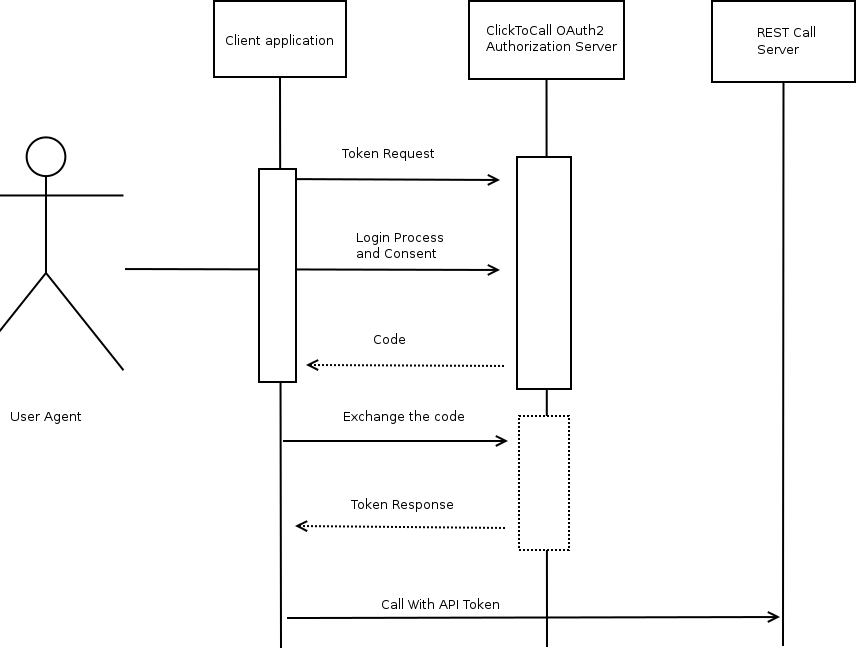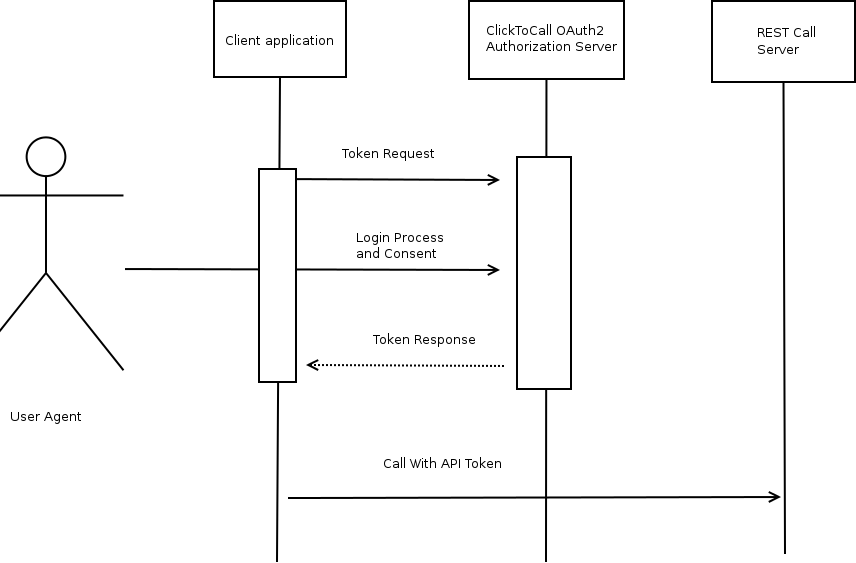REST API¶
In this section will describe the REST API.
Authorization Process¶
This project use the oAuth 2.0 process ( Draft 31 ). The Authentications Flow processes supported are two.
- Application Flow
- Client-Side Flow
Application Flow¶
This is used if the tester is with a web server application ( php, java, python, ruby, C#, etc.). The sequence is described in this image.

The scenario is redirecting the User-Agent to the login page ( popup etc.). The url to call from the Client Application is.
GET http://localhost:8888/oauth/auth
is Mandatory add the following parameter to this url
- client_id: * This is the client id added to the database in the client table *
- response_type: * For the Application Flow this value is
code*
- redirect_uri: * This is the redirect uri added into the database in the client table for the client_id *
- scope: * The scope in this project is not processed, have only one scope and is call *
Warning
This project have a test page for the redirect process, this page is
this page return the code and the token after the grant process and the token creation!
So, in conclusion the final url for the client auth is.
GET http://localhost:8888/oauth/auth?client_id=<client_id>&response_type=code&redirect_uri=http://localhost:8888/test&scope=call
After calling this url, the system automatically redirect to the Login-Page, the redirection is a 302 Status Code The login Page URL where the User-Agent is redirect is:
GET http://localhost:8888/auth/login?client_id=<client_id>&response_type=code&redirect_uri=http://localhost:8888/test&scope=call
The page show JSON formatted String with the parameters attached to the URL.
If the User-Agent is already Logged, the System redirect with a 303 status code to the Grant page.
If the user is not logged in, is necessary to send a post to the same url, with the username and password parameters.
POST http://localhost:8888/auth/login
body_parms:
client_id=<client_id>&response_type=code&redirect_uri=http://localhost:8888/test&scope=call&username=<user_username>&password=<user_password>
If the login is processed correctly, the System redirect to the Grant Page. This is the process that authorize the Application-ID take some information of the User-Agent. In a classic project this page show a form with two button, Accept Refuse. In this project is returned a json string with the parameters passed to the URL from the login page. If the User-Agent never have Grnated the Application-ID must be send a POST to the same url:
POST http://localhost:8888/auth/grant
body_params:
client_id=<client_id>&response_type=code&redirect_uri=http://localhost:8888/test&scope=call&grant=true
In this example the User-Agent has sent grant=true so he have accepted the Application Access.
Now the system redirect to the redirect_uri passed as a parameter.
if you is used the test page ``http://localhost:8888/test`` you will take the code from the body that show a JSON String.
The redirect is:
GET http://localhost:8888/test?code=<code>
After this process will be can take the token with the code returned. To obtain the token you need to send a GET to this url and with thsi parameters.
GET http://localhost:8888/oauth/token?client_id=<client_id>&client_secret=<secret_id>&code=<code>&redirect_uri=http://localhost:8888/test&grant_type=authorization_code
In this URl have one new parameter client_secret. This parameter is one column in the Client Table and is the password for the Application.
After call this URL, the System will be redirect to the redirect_uri , like the code step, this page show in the body a JSON string with the token code, the redirection is with a 303 status code.
The url called is:
GET http://localhost:8888/test#access_token=<token>&token_type=Bearer&expires_in=3600
Now with the token is possible to call the REST Server.
Client-Side Flow¶
This Flow is practically the same as the Application-Flow. This is used by Javascript Application ( client-side ). In the image have the flow view of the process.

This process will not request the token from a code authentication. the url flow is:
GET http://localhost:8888/oauth/auth?client_id=<client_id>&response_type=token&redirect_uri=http://localhost:8888/test&scope=call
login redirection:
GET http://localhost:8888/auth/login?client_id=<client_id>&response_type=token&redirect_uri=http://localhost:8888/test&scope=call
Send the post to login the user:
POST http://localhost:8888/auth/login
body_parms:
client_id=<client_id>&response_type=token&redirect_uri=http://localhost:8888/test&scope=call&username=<user_username>&password=<user_password>
grant if is not granted, if the customer is granted will be automatically redirect to the redirect_uri:
POST http://localhost:8888/auth/grant
body_params:
client_id=<client_id>&response_type=token&redirect_uri=http://localhost:8888/test&scope=call&grant=true
after this step, the system redirect to the page and send the parameters as:
GET http://localhost:8888/test#access_token=<token>&token_type=Bearer&expires_in=3600
Now is possible to call the REST Sever
REST Call Interface¶
HowTo send the token for authentication¶
Is possible to send the token in two methods. as a URL parameter:
GET http://localhost:8888/rest/call?access_token=<access_token>
or in the header:
POST /rest/call HTTP/1.1
Host: localhost:8888
User-Agent: PersonalUser-Agent
Authentication: Bearer <your-token>
Is important to add the Bearer parameter to stay compliant with the oAuth2 protocol.
Make a call¶
Send a POST to this url:
POST http://localhost:8888/rest/call
The parameter to send in the post is number=<number_to_call
If all work well you will obtain a status code 201, in the Location header you will obtain the GET URL with the token call to get the call information:
RESPONSE:
HTTP/1.1 201 OK
Server: xLightweb/2.6
Content-Length: 0
Location: http://localhost:8888/rest/call?token_call=<token_call>
Content-Type: application/x-www-form-urlencoded
Stop a Call¶
Send a PUT to this url:
PUT http://localhost:8888/rest/call
And in the PUT body this parameter:
token_call=<token_call>
This method return a status code 200
Get Call info¶
To get informations about a call you need to send a GET request:
GET http://localhost:8888/rest/call?token_call=<token_call>
Yu will obtain a JSON string or a xml string with the call information. if have some problems will return 409 error Conflict
Get All Ongoing Calls¶
To get all ongoing calls you need to send a GET to this url whitout any parameter:
GET http://localhost:8888/rest/call
The result is a JSON or a XML string with all the ongoing calls for the logged user.